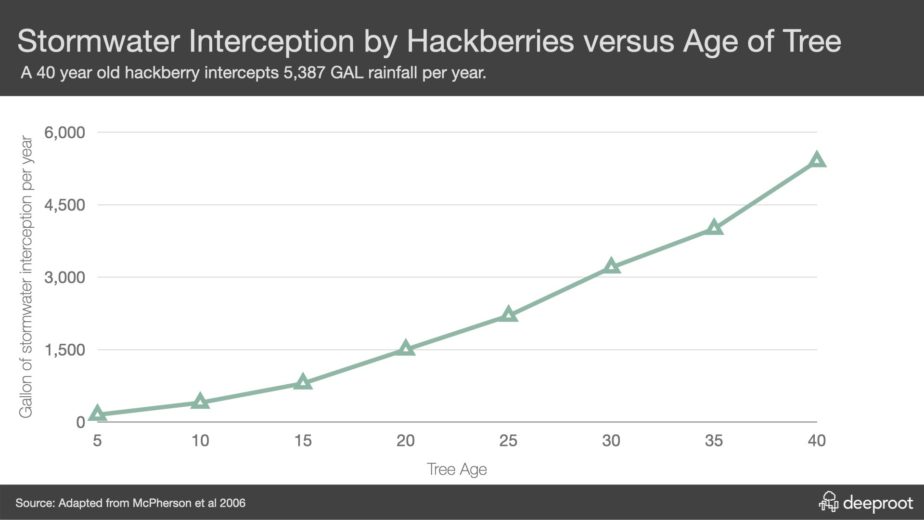A big part of this blog is devoted to the discussion of trees, soil, and stormwater in the urban context. Today we want to walk through the three processes that allow trees in uncompacted soil to provide stormwater quantity and rate control benefits:
- Soil storage
- Interception
- Evapotranspiration
Soil Storage
Soil stores rain water during and after a storm, making it available for plant growth. Stormwater runoff from nearby impervious surfaces can be directed into soil under suspended pavement using a number of different techniques, such as, for example, through pervious pavement installed over the cells, or via a perforated pipe off a trench drain or manhole.
A typical tree in suspended pavement can hold the 2.54 cm (1 inch) storm event from impervious surface area significantly greater than just the area under the tree canopy.
For example, one tree with 28.3 m3 (1000 cubic feet) of uncompacted soil with 20% soil water storage capacity (a conservative estimate since some bioretention soils can hold up to 40% water) can hold the 2.54 cm (one inch) 24 hour storm event from 223 m2 (2,400 square feet) of impervious surface.
Stormwater calculations for trees for bioretention typically account only for soil storage, not for interception and evapotranspiration.
Interception
Interception is the amount of rainfall temporarily held on tree leaves and stem surfaces. This rain then drips from leaf surfaces and flows down the stem surface to the ground or evaporates.
Interception is not typically included in stormwater calculations but can nonetheless provide additional stormwater benefits beyond stormwater storage in the soil.
The volume of rain intercepted depends on the duration and rate of the rainfall event, tree architecture (e.g. leaf and stem surface area, roughness, visual density of the crown, tree size, and foliation period), and other meteorological factors.
Since larger trees have more leaves to intercept rain, they intercept significantly more rain than small trees, with interception increasing at a faster rate than tree age. For example, a model of a hackberry tree in the Midwest estimates that interception will increase as follows with tree age:
- a 5 year old hackberry intercepts 0.5 m3 (133 GAL) rainfall per year
- a 20 year old hackberry intercepts 5.3 m3 (1,394 GAL) rainfall per year
- a 40 year old hackberry intercepts 20.4 m3 (5,387 GAL) rainfall per year

Stormwater interception by hackberry trees versus age of tree (adapted from McPherson et al, 2006)
Evapotranspiration
Evapotranspiration (ET) is the sum of water evaporated from soil and plant surfaces and the water lost as a result of transpiration, a process in which trees absorb water through their roots and transfer it up to the leaves, where it evaporates into the environment through leaf pore transpiration. Evapotranspiration continues to reduce stormwater volume stored in the soil long after a rainfall event ends.
Transpiration rate is influenced by factors such as tree species, size, soil moisture, increasing sunlight (duration and intensity), air temperature, wind speed and decreasing relative humidity.
Potential evapotranspiration (PET) exceeds precipitation during the growing season in much of the US. Even tree transpiration can exceed precipitation where it is sustained by irrigation (Grimmond and Oke 1999). A study by Sinclair et al (2005) showed that:
“Transpiration was unaffected by soil drying until the initial estimated transpirable soil water fraction had decreased to between 0.23 and 0.32 of that at field capacity. Beyond this point, transpiration rate declined linearly with available soil water fraction until reaching one fifth the rate observed in well watered plants. With further soil drying, the relative transpiration rates remained between 10 and 20% of that observed in well watered plants.”
Transpiration uses heat from the air to change the water in the vegetation into water vapor, so in addition to providing stormwater benefits, transpiration also decreases ambient air temperature and reduces the urban heat island effect. Trees in a parking lot in Davis, CA, for example, reduced asphalt temperatures by as much as 20° C (36° F), and car interior temperatures by over 26° C (47° F) (Scott et al 1999).
It is the responsibility of designers to create conditions that are favorable to trees and the sustainable processes that they enable to occur in the built environment. Hopefully this outline of their incredible benefits will help professionals to make sure sites that the sites they design continue to support these ecological principles.







Is there good information available to calculate ecosystem services trade-offs, for example, stormwater benefits based on variables such as soil volume, canopy diameter, and tree DBH?
Leda, did you answer Abigail’s question?
Hi Alan, we did not specifically answer her question in a subsequent blog posts. Since writing, however, many new resources have been developed that can be used in this effort. You can read about some of them in this recent post: http://www.deeproot.com/blog/blog-entries/performance-metrics-for-sustainable-landscapes